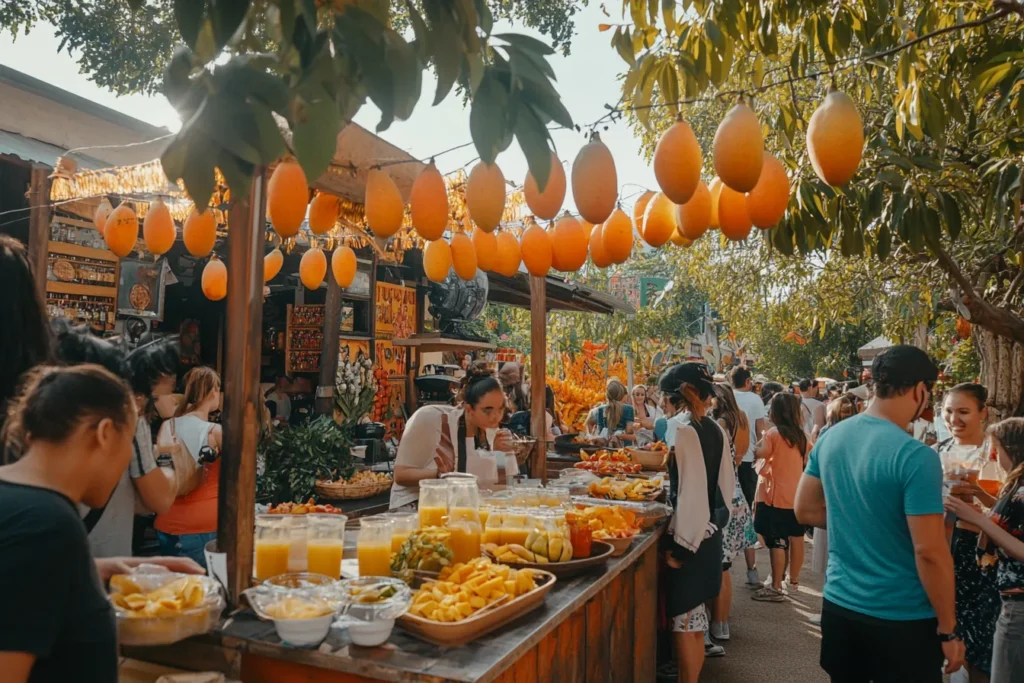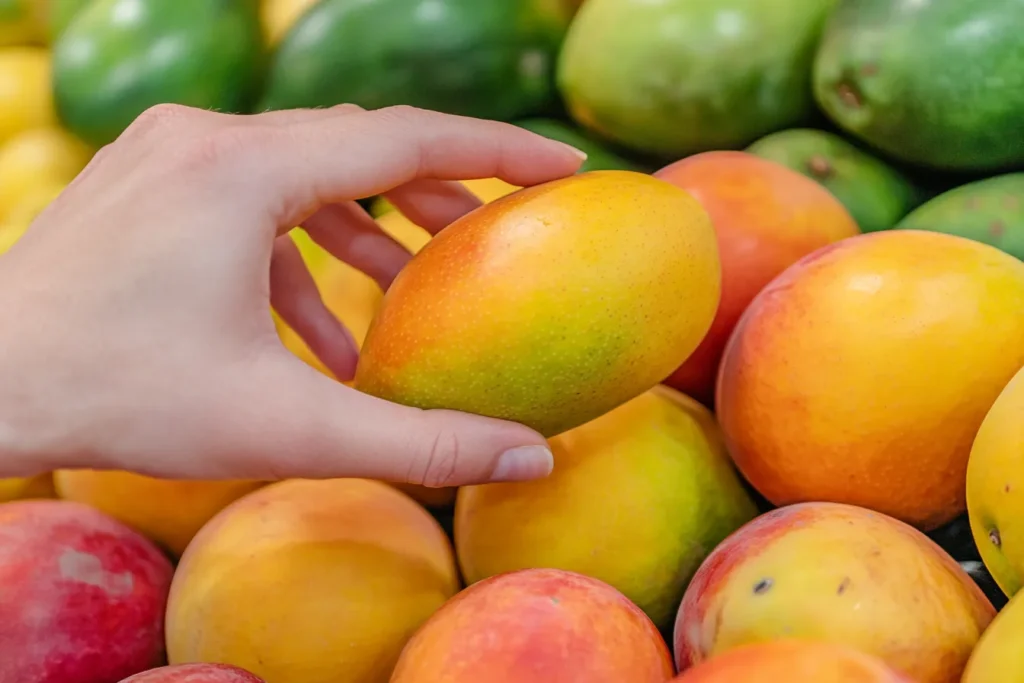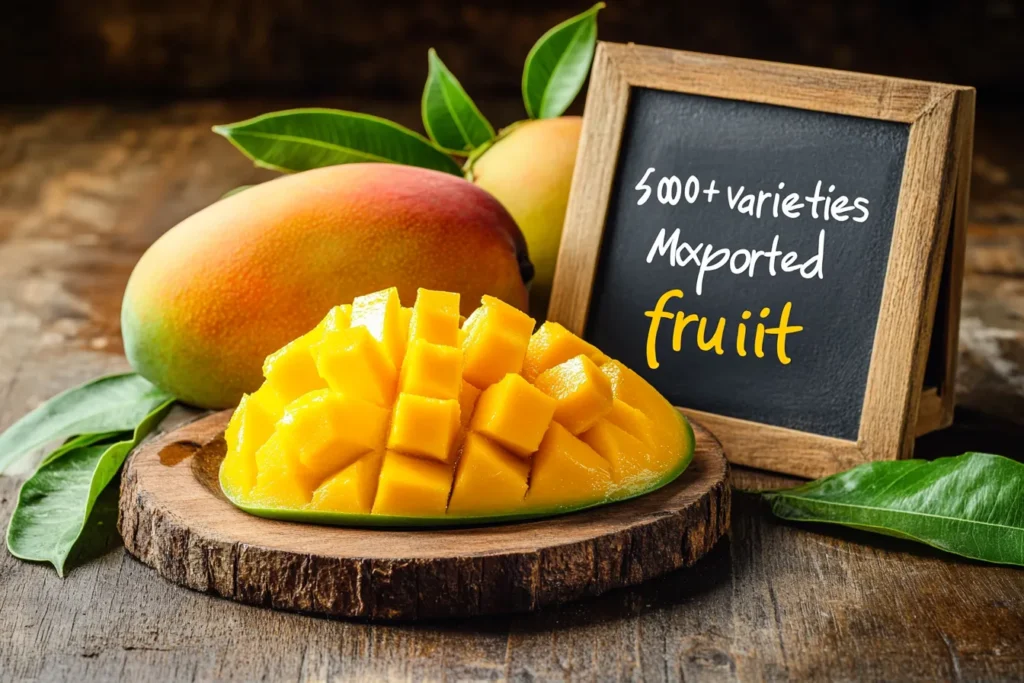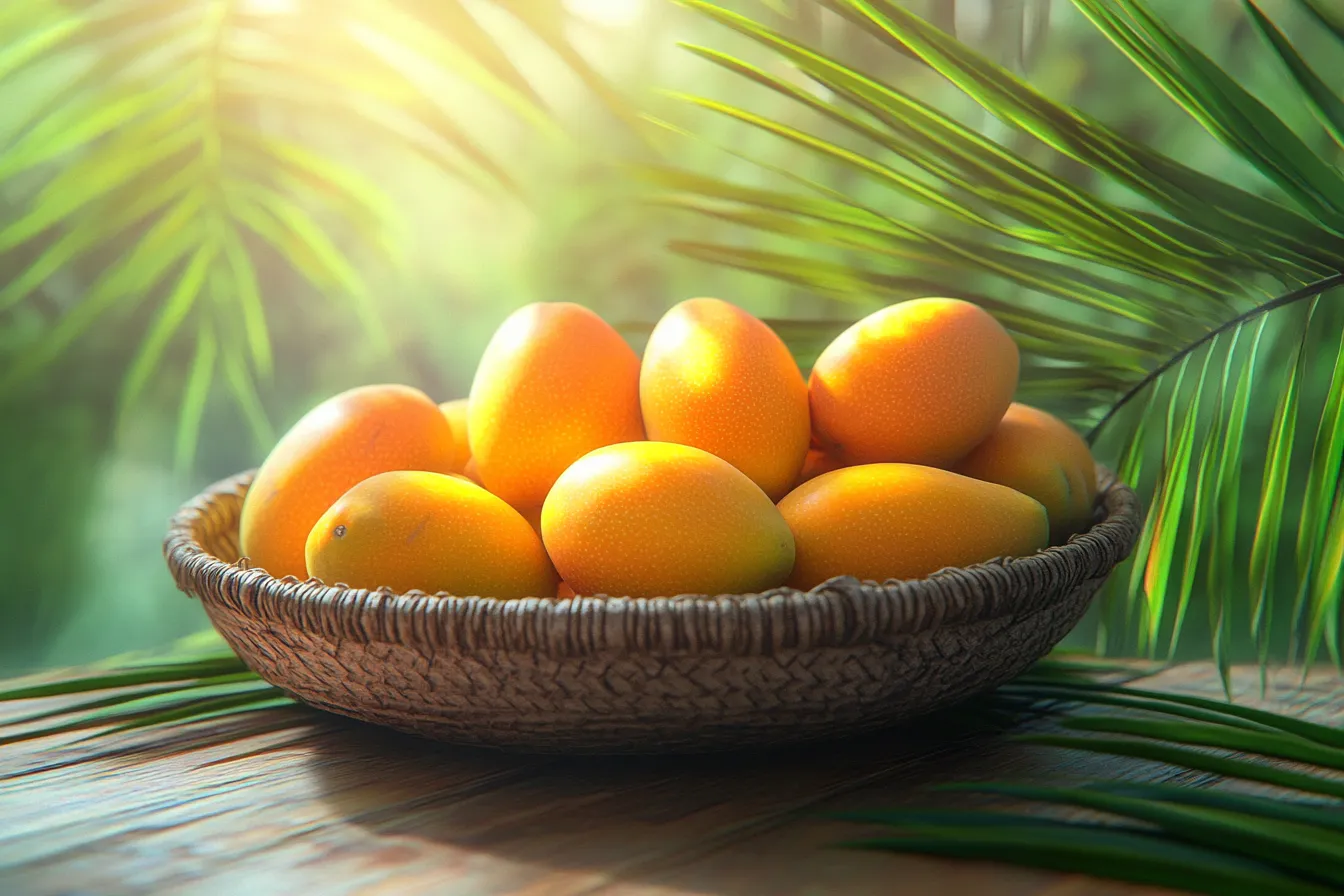Introduction
Sweet, juicy, and loaded with flavor — the mango has earned its royal title as the King of Fruits. And what better way to honor this luscious tropical gem than by dedicating an entire day to its celebration? National Mango Day, observed every year, is more than just an ode to a fruit. It’s a cultural, culinary, and nutritional festival that shines a light on one of nature’s tastiest treasures.
From health benefits to rich historical roots, the mango isn’t just delicious — it’s powerful. Countries across the globe revere it not only in cuisine but in folklore, health remedies, and spiritual traditions. For mango lovers everywhere, National Mango Day is an invitation to savor, share, and discover everything about this golden fruit.
In this blog, we’re peeling back the layers on why this day is so special, how you can celebrate it, and what makes mangoes so worth your attention — and appetite..Ice Cream for Breakfast Day
Whether you’re biting into a fresh Alphonso, stirring up a mango smoothie, or heading out to a mango-themed food festival, this guide will walk you through everything you need to know about National Mango Day.
Ready to dive into the juicy world of mangoes? Let’s go!
What Is National Mango Day?
Origin & History of the Celebration
National Mango Day has been gradually gaining attention as a delicious summer holiday dedicated to enjoying the world’s most beloved tropical fruit. While the origins are somewhat informal and not attributed to a single founding organization, food enthusiasts and health advocates started the tradition to highlight the mango’s widespread appeal and nutritional value.
Over the years, various institutions — such as the National Mango Board — have embraced the idea by launching promotional campaigns, hosting educational programs, and supporting mango-themed events. The day also promotes sustainable agriculture and helps raise awareness about the mango industry, both in the U.S. and abroad.
Why August 22nd Is Mango Day
Unlike National Fruit Day or other general food holidays, National Mango Day is typically celebrated on July 22nd in many regions, while some communities observe it on August 22nd, aligning it with seasonal mango harvests. These summer months mark peak mango season in countries like the U.S., Mexico, India, and the Philippines, making it a perfect time to celebrate mangoes in their freshest, ripest state.
Despite variations in date, the spirit of the day remains the same: celebrating everything mango — its vibrant flavors, nutritional benefits, and cultural significance..Pulse Mojito

Mango’s Global Popularity
Largest Mango‑Growing Regions
Mangoes are truly global — cultivated in over 100 countries around the world. But a few nations stand out as the top mango producers. India reigns supreme, producing over 40% of the world’s mango supply. Varieties like Alphonso, Kesar, Dasheri, and Langra are highly prized for their unique taste and aroma.
Mexico, the second-largest producer, leads in mango exports, especially to the United States and Canada. Mexican mangoes — like Ataulfo and Haden — are known for their creamy texture and long shelf life, making them perfect for international markets.
Thailand, Indonesia, Pakistan, Egypt, and Brazil also rank high in global mango production. Each region boasts unique cultivars that thrive in their respective climates. The United States, particularly Florida and California, also cultivates mangoes, although on a smaller scale.
This wide distribution not only helps meet global demand but also allows different varieties to flourish across regions, making mangoes accessible almost year-round in many places.
Mango in Culture & Cuisine Worldwide
Mangoes are more than just a fruit — they’re woven into the very fabric of cultural identity in many parts of the world. In India, mango leaves are used in religious rituals, weddings, and housewarmings, believed to bring prosperity. In Southeast Asia, mango sticky rice is a staple dessert that draws both locals and tourists alike.
Across the Caribbean and Central America, mangoes appear in salsas, grilled dishes, and refreshing drinks like mango limeades. In Africa, green mangoes are often used in chutneys and savory stews.
The versatility of mango means it crosses boundaries — you’ll find it in spicy pickles in Pakistan, smoothies in the U.S., cakes in Japan, and frozen treats in Brazil. Its universal appeal has made it a beloved ingredient across all cuisines, from street food to fine dining.
Top 5 Health Benefits of Mango
Rich in Vitamins & Antioxidants
Mangoes are a nutritional powerhouse, packed with essential vitamins and antioxidants. Just one cup of sliced mango delivers about 67% of your daily Vitamin C intake. This potent antioxidant supports immune function, collagen production, and skin health.
They’re also a good source of Vitamin A, which aids eye health and boosts immunity, along with Vitamin E, Vitamin K, and several B vitamins, including folate.
Mangoes contain polyphenols — plant compounds with antioxidant properties. One of the most potent is mangiferin, which has been studied for its potential anti-inflammatory, anti-cancer, and heart-protective properties.
Boosts Immunity
Thanks to its high vitamin content — particularly Vitamin C and A — mangoes are a natural immunity booster. These vitamins strengthen your body’s defense systems, helping fight off infections, bacteria, and viruses.
In addition to vitamins, mangoes are rich in beta-carotene, which your body converts into Vitamin A. This plays a crucial role in maintaining mucous membranes and skin — your first line of defense against pathogens.
Aids Digestion
Mangoes contain digestive enzymes like amylases, which help break down large food molecules and promote smooth digestion. They’re especially useful after a heavy meal.
The fiber in mango also aids in preventing constipation and promoting a healthy gut. One medium mango provides about 3 grams of fiber, a solid contribution to your daily recommended intake.
The high water content (nearly 80%) also keeps the digestive system hydrated and running efficiently, making mangoes a natural solution for digestive support.
Suggestions (included in article):
- National Mango Board — (anchor text: “National Mango Board’s mission and campaigns”)
- USDA Mango Nutrition Data — (anchor text: “mango’s nutrition profile from the USDA”)
- Epicurious Mango Recipes — (anchor text: “delicious mango recipes to try at home”)

How to Celebrate National Mango Day
National Mango Day isn’t just a chance to eat your favorite fruit—it’s an opportunity to engage in creative, flavorful, and even educational ways of celebrating. Whether you’re at home with family or attending a community event, there are countless ways to honor the king of fruits on its special day.
Mango‑Themed Events & Festivals
In the United States, the National Mango Board has been instrumental in promoting mango-focused events across the country. One of their most engaging efforts is the Joy Ride Tour, which visits local markets and communities like HEB Mansfield, as highlighted by Focus Daily News. These events include free mango samples, chef-led cooking demos, nutrition education booths, and even giveaways.
In countries like India, where mangoes are a cultural staple, festivals such as the International Mango Festival in Delhi draw thousands of attendees. This event showcases hundreds of mango varieties, along with mango-eating contests, recipe showcases, and agricultural exhibitions.
Mango festivals often include:
- Cooking classes and demos by celebrity chefs
- Mango-inspired art exhibitions and photography contests
- Cultural performances that tie into mango-themed traditions
- Educational booths about mango farming and sustainability
Attending one of these events not only supports local farmers and businesses but also deepens your appreciation for this fruit’s global cultural significance.
Fun At‑Home Mango Recipes
If you can’t make it to an event, celebrating at home can be just as festive. Mangoes are incredibly versatile, making them perfect for sweet and savory creations alike.
Smoothies & Desserts
Mango lends itself beautifully to chilled summer treats. You can blend it into a classic mango smoothie with Greek yogurt, banana, and honey, or freeze it into homemade mango popsicles with lime and mint.
For dessert lovers, try baking a mango cheesecake, crafting a no-churn mango ice cream, or layering it into a refreshing mango trifle with cream and cake.
Savory Mango Salads & Salsas
Mango also adds a sweet-tart punch to savory dishes. Dice it into a spicy mango salsa to pair with grilled fish or tacos. Toss it in a mango and avocado salad with arugula, goat cheese, and a lime vinaigrette for a gourmet summer lunch.
You can even make a mango curry — a tropical dish popular in Southern India and parts of Sri Lanka — where ripe mangoes simmer with coconut milk and spices for a mouthwatering vegetarian entrée.
These dishes are great for hosting a mango party or picnic. Make it interactive by setting up a “Mango Bar” where guests can customize their own mango drinks or parfaits.
Social Media Challenges & Community Sharing
Participating in a mango challenge on social media is another fun way to engage. Hashtags like #NationalMangoDay, #MangoMadness, and #MangoLove are trending around the holiday, making it easy to share your favorite mango dishes, memories, or even fashion inspired by mangoes.
You can also create your own mini campaign — share a mango recipe video, write a blog post, or go live while preparing your favorite dish. It’s a fun way to connect with other mango lovers across the globe and add some digital flavor to your celebration.
Get Kids Involved
National Mango Day is a great time to teach children about healthy eating. Get them involved in:
- Cutting mangoes (with supervision)
- Making their own smoothies or popsicles
- Learning fun mango facts through games or crafts
- Drawing or painting their favorite mango dish
Incorporating mango activities into their day helps develop a love for healthy food while making the holiday even more special for the whole family.
Mango Board’s Role & Joy Ride Tour
Mission of the National Mango Board
The National Mango Board (NMB) plays a central role in educating the public about the benefits, origins, and versatility of mangoes. Established under the U.S. Department of Agriculture, this organization is funded by mango importers and distributors to promote mango consumption across the United States.
Its mission? Simple yet powerful: “Increase consumption of fresh mangos in the U.S. through research and promotional activities.”
Here’s how they do it:
- Nutrition education: They provide research-based content about the health benefits of mangoes.
- Marketing campaigns: Through seasonal ads, supermarket promotions, and digital marketing, the NMB boosts mango visibility.
- Consumer engagement: Initiatives like recipe contests, cooking demonstrations, and influencer partnerships increase public interest.
- Retail and foodservice support: They offer tools and training to help grocers, chefs, and foodservice professionals incorporate mango into their offerings.
What sets the Mango Board apart is its collaborative approach. By partnering with chefs, dietitians, and community leaders, they ensure mangoes remain a delicious and relevant part of American diets.
For more info, visit the National Mango Board’s official site.
Joy Ride Tour Highlights
One of the NMB’s most engaging and widely appreciated campaigns is the Joy Ride Tour — a seasonal mango-themed event that travels across U.S. cities to spread mango love in person.
Take the HEB Mansfield event, as reported by Focus Daily News. This stop included:
- Free mango samples: Visitors could try different mango varieties and learn how to identify ripe fruit.
- Live cooking demos: Chefs created innovative mango recipes on the spot.
- Educational booths: Visitors learned how mangoes are grown, harvested, and shipped.
- Giveaways & photo ops: With fun props and mango-themed decor, families could snap selfies while taking home recipe cards and mango swag.
The Joy Ride Tour is about more than just fun—it’s an interactive experience that bridges the gap between farm and fork. Participants leave with a deeper appreciation for the fruit and fresh ideas for using it in everyday meals.

Mango Buying & Storage Tips
Buying mangoes might seem simple, but selecting a ripe one (without slicing it open!) is a skill worth mastering. Let’s explore some tips.
How to Choose a Perfect Mango
Mangoes come in various shapes, sizes, and colors — so don’t rely on color alone. Here’s what to look for:
- Feel: Gently squeeze the mango. A ripe one will give slightly to pressure, similar to a ripe peach or avocado.
- Smell: Ripe mangoes often give off a sweet, fruity aroma near the stem.
- Skin: Small blemishes are okay. Just avoid shriveled skin or large black spots, which indicate overripeness or spoilage.
Each mango variety ripens differently. For instance:
- Ataulfo (Honey Mango): Turns deep golden yellow and slightly wrinkled when ripe.
- Tommy Atkins: Mostly red with green — firmness is a better indicator than color.
Ripening & Storage Hacks
If your mango isn’t ripe yet, try one of these tricks:
- Paper Bag Method: Place the mango in a brown paper bag at room temperature. This traps ethylene gas and speeds ripening.
- Add a Banana: Bananas emit ethylene naturally — placing one in the bag with your mango will turbocharge the process.
Once ripe, mangoes can be stored in the fridge for up to 5 days. Cut mango should be stored in an airtight container and consumed within 2–3 days.
You can also freeze mangoes for smoothies or desserts. Simply peel, dice, and spread the cubes on a tray. Once frozen, transfer them to a zip-lock bag for longer storage.

Mango Fun Facts & Trivia
There’s no denying that mangoes are one of the most celebrated fruits in the world—but beyond their delicious flavor, mangoes are filled with fascinating stories, stats, and surprises. Here are some incredible mango facts that are sure to amaze you on National Mango Day!
Most Varieties Worldwide
Did you know there are over 500 mango varieties around the globe? That’s right—from sweet and creamy Alphonso to tart and fibrous Keitt, each variety has its own distinct flavor, color, and texture. Some of the most popular varieties include:
- Alphonso (India): Known for its intense sweetness and rich aroma.
- Tommy Atkins (USA & Mexico): One of the most widely available varieties in American supermarkets.
- Haden (Florida): Bright red blush with excellent flavor.
- Keitt (California & Mexico): Less fibrous and stays green when ripe.
- Ataulfo (Mexico): Also known as Honey Mango, creamy texture with a small pit.
Each country tends to favor different varieties depending on climate and culinary preferences, making the global mango scene incredibly diverse.
Record‑Breaking Mangoes
If you’re a fan of world records, mangoes don’t disappoint! In 2020, a farmer in the Philippines grew a mango weighing 4.25 pounds, which earned a place in the Guinness World Records. That’s about the size of a small bowling ball!
India holds a place of pride with the Alphonso mango, often dubbed the “Ferrari of mangoes.” It’s one of the most expensive fruits on the market, with boxes of Alphonsos selling for over $100 during peak season.
In Japan, Taiyo no Tamago (Eggs of the Sun) mangoes can fetch up to $3,000 per pair at auction due to their perfect shape, rich flavor, and luxurious presentation.
FAQs About Mango & National Mango Day
To make this article more useful for all mango lovers, we’ve gathered the most commonly asked questions and provided simple, clear answers.
8.1. What does the National Mango Board do?
The National Mango Board is a U.S. organization dedicated to promoting mango consumption. They fund research, provide recipes and nutrition info, run events like the Joy Ride Tour, and help retailers and food service businesses incorporate mangoes into their offerings. Learn more on their official website.
8.2. Are mangoes good for weight loss?
Yes! Mangoes are naturally low in fat, cholesterol, and sodium. They’re high in fiber, which promotes fullness, and vitamin C, which supports metabolism. Just be mindful of portion sizes if you’re watching sugar intake. A cup of fresh mango contains about 100 calories and 23 grams of natural sugar — perfect as a pre-workout snack or a healthy dessert.
8.3. Can you eat mango seeds?
While mango seeds are not typically eaten raw due to their hard texture and bitter flavor, they can be used in cooking or ground into powder for use in traditional medicines in some cultures. They’re rich in antioxidants and have been studied for their anti-inflammatory properties. However, consult a nutritionist or doctor before consuming mango seeds regularly.
8.4. What’s the best way to cut a mango?
The easiest method is the “hedgehog style.” Slice off the two cheeks (sides) around the pit, score the flesh in a criss-cross pattern without cutting through the skin, and then flip it inside-out. Scoop out the cubes with a spoon. You can also use a mango slicer for convenience.
8.5. Can dogs eat mango?
Yes, dogs can enjoy small amounts of mango as a treat! Just make sure to remove the pit and skin. Mango is a good source of vitamins A, B6, and C for pets, but too much can lead to an upset stomach due to its fiber and sugar content.
8.6. When is mango season in the U.S.?
U.S. mangoes are available year-round thanks to imports from Mexico, Peru, Ecuador, and other countries. However, the peak season runs from March through July, making National Mango Day (in July or August) the perfect time to enjoy fresh, juicy fruit.
Conclusion
National Mango Day is more than a celebration of a delicious fruit — it’s a tribute to tradition, culture, health, and global unity. Whether you’re savoring a juicy slice of Alphonso, blending a mango smoothie, or joining in a community mango event, this day reminds us of the vibrant joy that simple fruits can bring into our lives.
With its impressive nutritional profile, year-round availability, and global popularity, the mango continues to win hearts around the world. From farms to festivals and kitchens to classrooms, this golden gem stands out not just for its taste but for the rich history and meaning it carries.
So, this National Mango Day, take a moment to enjoy a mango in your favorite way. Try a new recipe, share it with friends, or visit a local market to support mango growers and vendors. The celebration doesn’t have to end in one day — with mangoes in your fridge or freezer, every day can be a sweet and sunny tribute to the King of Fruits.

Name: Refreshing Mango Smoothie
Ingredients
Equipment
Method
- Instructions:
- Peel and dice the mango if using fresh.
- Add mango, yogurt, milk, ice, honey, and lime juice to a blender.
- Blend until smooth and creamy (about 30–60 seconds).
- Taste and adjust sweetness or thickness (add more milk or honey as needed).
- Pour into chilled glasses and garnish with mint leaves.
- Serve immediately and enjoy!
